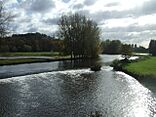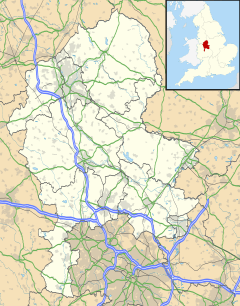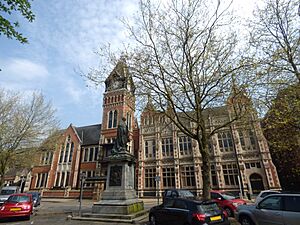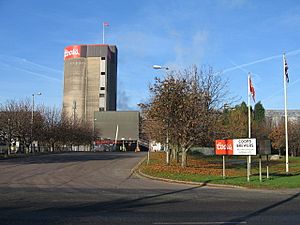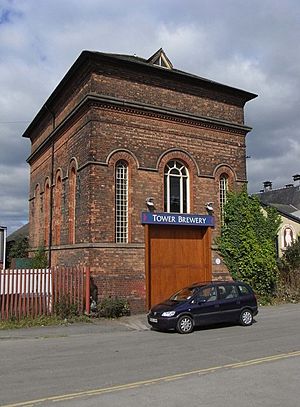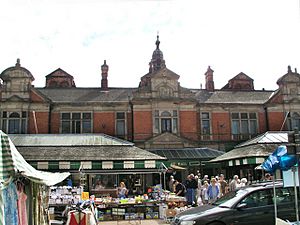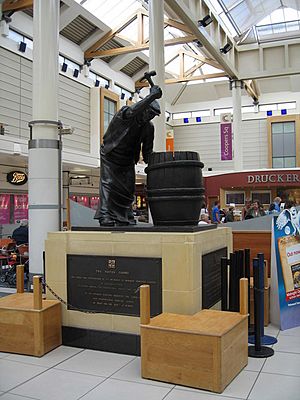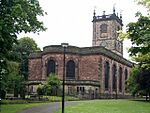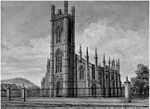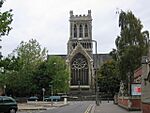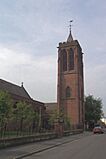Burton upon Trent facts for kids
Quick facts for kids Burton upon Trent
|
|
|---|---|
| Town | |
|
|
| Population | 76,270 (2021 Census) |
| OS grid reference | SK245225 |
| District |
|
| Shire county | |
| Region | |
| Country | England |
| Sovereign state | United Kingdom |
| Post town | BURTON-ON-TRENT |
| Postcode district | DE13-DE15 |
| Dialling code | 01283 |
| Police | Staffordshire |
| Fire | Staffordshire |
| Ambulance | West Midlands |
| EU Parliament | West Midlands |
| UK Parliament |
|
Burton upon Trent, often called Burton-on-Trent or just Burton, is a lively market town in Staffordshire, England. It's very close to the border with Derbyshire. In 2021, about 76,270 people lived there. People from Burton are called Burtonians. The town sits on the River Trent, about 11 miles (18 km) southwest of Derby. It's also 20 miles (32 km) south of the beautiful Peak District National Park.
Burton is famous for its history of brewing. The town first grew around Burton Abbey, a very old monastery. The Burton Bridge was also important. Two battles happened there, one in 1322 and another in 1643 during the First English Civil War. Over time, Burton became a busy market town.
The town has its own train station, Burton-on-Trent railway station. It used to be connected to other towns like Lichfield and Walsall by the South Staffordshire Line, which is now closed.
Contents
What's in a Name?
The name Burton upon Trent means "a settlement at a fortified place" along the River Trent. This name has been used since the 8th century.
While the official name is Burton upon Trent, the postal service and the train station use 'Burton-on-Trent'.
Burton's Past: A Journey Through Time
Ancient Roads and Early Settlements
A very old Roman road called Ryknild Street once passed through the area where Burton now stands. This road connected Roman settlements like Letocetum (near Lichfield) and Derventio (Little Chester) (near Derby).
Around 666 to 669 AD, a bishop named Wilfrid started monasteries in Mercia, a powerful Anglo-Saxon kingdom. Burton was likely one of these places. An island in the River Trent, called Andresey, means "Andrew's isle." It refers to a church dedicated to St Andrew there. This island is also linked to the story of St Modwen, an Irish abbess. Any early religious buildings were probably destroyed when the Danish people invaded in 874.
The Rise of Burton Abbey
In 1003, a Benedictine abbey was built on the west bank of the Trent by a nobleman named Wulfric Spott. This was a very important monastery in Staffordshire. By the 1530s, it was one of the richest. Kings like William I, Henry II, and Edward I often visited the abbey.
In the 12th and 13th centuries, new streets were built near the abbey. New Street led from the abbey gates towards the old Roman road. Horninglow Street, at the north end of High Street, was part of a main route that used the bridge over the river.
Markets and Fairs
On April 12, 1200, King John gave the Abbot of Burton permission to hold a market every Thursday. This permission was later renewed by other kings. The town also had four yearly fairs where people traded horses, cattle, and other goods. These fairs are not held anymore.

The large bridge over the Trent was very important. It was a "common passage" for many travelers. This bridge was the site of two battles. In 1322, King Edward II defeated a rebel leader there. In 1643, during the First English Civil War, the Royalist army captured the town at this bridge.
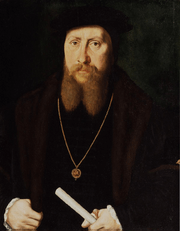
The Abbey's End and New Beginnings
In 1539, during the time of Henry VIII, Burton Abbey was closed down. Its lands were given to Sir William Paget in 1545. Sir William planned to turn the old manor house within the abbey grounds into a grand home. He used stones and materials from the abbey buildings for this project.
In 1585, it was suggested that Mary, Queen of Scots might stay in Burton. However, the manor house was described as "ruinous" and the town as "full of bad neighbours." The Paget family later lost their lands for a while due to plots against Queen Elizabeth I. Parts of the abbey church were used by the local community for a time, but a new church was built in 1719–1726. Only small parts of the old abbey remain today.
Canals and the Rise of Brewing
In 1699, William Lord Paget helped get a law passed to make the River Trent easier to travel on by boat up to Burton. In 1712, this river navigation opened, and a wharf (a place for boats to load and unload) was built. This was a huge step for Burton. It meant that beer brewed in Burton could be shipped to places like Hull, then across the Baltic Sea, and even to London.
Many breweries opened in the late 1700s. When trade with other countries became difficult, brewers focused on London and other parts of England. Burton became famous for its pale ale. The local water in Burton is special because it has a lot of natural salts. This unique water quality, a process called Burtonisation, helped brewers make a special type of beer called India Pale Ale. This beer was made to stay fresh during long sea trips to India. New train lines to Liverpool also helped brewers send their beer all over the British Empire.
Burton became the most important town for brewing. At its peak, one-quarter of all beer sold in Britain was made here. In the late 1800s, there were over 30 breweries in Burton. However, in the early 1900s, beer sales dropped, and many breweries closed or merged. By 1980, only three main breweries remained: Bass, Ind Coope, and Marston's.
Burton was also home to the Peel family, who were important during the Industrial Revolution. Their family home, Peel House, can still be seen today. Queen Elizabeth II visited Burton in 2002 during her Golden Jubilee.
How Burton is Governed
Burton has three levels of local government:
- Staffordshire County Council (for the whole county)
- East Staffordshire Borough Council (for the local area)
- Several parish councils for different parts of the town.
Burton is the main office for the East Staffordshire borough. It is also part of the Burton and Uttoxeter area for the UK Parliament. The local Member of Parliament (MP) is Jacob Collier from the Labour Party.
A Look at Local Government History
Burton upon Trent was a very old parish that crossed the border between Staffordshire and Derbyshire. Over time, different parts of the parish became separate areas.
In 1779, a group of "improvement commissioners" was set up to help manage the town. Their area grew over the years. In 1878, this area officially became a municipal borough called Burton upon Trent. When county councils were created in 1889, parts of Burton that were in Derbyshire were moved into Staffordshire.
In 1891, the council was given a building that became the Burton upon Trent Town Hall. They made it bigger to use as their main office.
In 1901, Burton became a "county borough," which meant it was independent from Staffordshire County Council. This happened because its population reached 50,000. However, it didn't grow much larger than that. In 1974, the town became part of the new East Staffordshire district.
Since 2003, Burton has been divided into several smaller parishes, each with its own local council. The main Burton parish covers only the town centre.
Where is Burton?
Burton is about 109 miles (175 km) northwest of London and about 30 miles (48 km) northeast of Birmingham. It's on the eastern edge of Staffordshire, right next to Derbyshire. The River Trent forms part of the county boundary here. The town is also near the end of the Trent and Mersey Canal.
Burton is located within the northern part of the National Forest.
The town centre is in a valley next to the River Trent, about 50 meters above sea level. Nearby villages like Winshill and Stapenhill are higher, reaching 130 m and 100 m.
 |
Stoke-on-Trent, Uttoxeter, Tutbury | Hilton, Rolleston | Derby, Nottingham |  |
| Stafford, Abbots Bromley | Melbourne, East Midlands Airport | |||
| Barton-under-Needwood, Lichfield | Drakelow, Tamworth | Swadlincote, Ashby-de-la-Zouch |
Burton became a brewing hub partly because of its special local water. The water has many dissolved salts, mainly from gypsum in the nearby hills. This allowed brewers to use more hops, which helped preserve the beer. This meant beer could be shipped further away. Much of the land around Burton is protected to keep this water quality high.
Which Region?
There's sometimes confusion about whether Burton is in the West Midlands or the East Midlands. Even though the town is southwest of the River Dove (which is the border), it's officially in the West Midlands region because it's in Staffordshire.
However, the way people speak in Burton sounds more like the East Midlands. Also, it used to be in the East Midlands for electricity and gas, and it has Derby postcodes (DE13-DE15). But it's served by BBC and ITV channels based in Birmingham, which is in the West Midlands.
Green Spaces
The areas of Winshill, Brizlincote, and Stapenhill to the southeast of town are part of a "green belt." This is a protected area that stops uncontrolled building. It helps prevent Burton from merging with the nearby town of Swadlincote. Most of this green belt is in Derbyshire, with smaller parts in Staffordshire.
Who Lives in Burton?
In the 2021 Census, Burton's population was 76,270 people.
Here's a breakdown of the town's different groups:
- White - 60,895 (79.9%)
- Asian - 10,883 (14.3%)
- Mixed Race - 2,169 (2.8%)
- Black - 1,169 (1.5%)
- Other - 1,164 (1.3%)
And here's a look at the different religions in Burton:
- Christians - 34,140 (47.5%)
- No religion - 26,275 (36.5%)
- Muslims - 10,363 (14.4%)
- Other - 347 (0.5%)
- Hindus - 293 (0.4%)
- Sikhs - 268 (0.4%)
- Buddhists - 195 (0.3%)
- Jews - 13 (0.1%)
Burton's Economy
Brewing: Burton's Famous Industry
For hundreds of years, brewing has been Burton's main industry. It's still a very important part of the town's economy today.
Currently, there are eight breweries in Burton. These include Coors Brewers Ltd (which makes Carling and Worthington Bitter) and Marston's (which makes its own beers like Marston's Pedigree, and also Bass beer).
Smaller breweries like Burton Bridge Brewery, Tower Brewery, Old Cottage Brewery, Black Hole Brewery, and Gates Brewery also operate in the town.
Burton is also home to the offices of pub companies like Punch Taverns. The White Shield microbrewery is still open next to the National Brewery Centre.
A special food spread called Marmite is also made in Burton. It's a by-product of the brewing process. The factory moved to its current location in the 1960s. The production of Marmite also led to the making of Bovril. Both brands are owned by the company Unilever.
Making Things: Manufacturing
Eatough's was a shoe company that opened a factory in Burton in 1920. It was known for being the first British shoe factory to play music for its workers. However, it closed in 1989 due to competition.
Briggs of Burton is an engineering company that started in 1732. It's famous for making equipment for breweries and other industries around the world.
Thornewill and Warham was another old company in Burton, started in 1740. It made metal goods and later became known for building steam engines and railway locomotives.
Shopping in Burton
Burton has had a market since 1200. Today, it has both an indoor and an outdoor market. The Market Hall was built in 1883 and is open from Tuesday to Saturday. The outdoor market is held every Thursday, Friday, and Saturday.
The main shopping area is the Coopers Square shopping centre, which opened in 1970. It was updated in the 1990s with a roof. Other shopping centres include The Octagon Shopping Centre and Burton Place Shopping Centre. There's also the Middleway Retail Park, which has a Cineworld cinema, Mecca Bingo, and restaurants like Bella Italia and Nando's.
In 2005, a report said Burton was one of the top ten "clone towns" in England. This meant it had many of the same chain stores as other towns. Since then, events like a French market have been held to attract more visitors.
News and Media
Local news for Burton includes the Burton Mail newspaper, BBC Radio Derby, and Capital Mid-Counties.
Warehousing and Distribution
Burton's central location in England and its good transport links make it a popular place for warehouses. Many large companies have distribution centres here.
Some well-known businesses with warehouses in Burton include B&Q, Boots, Hobbycraft, Holland & Barrett, DHL, Waterstones, Clipper, and Amazon.
Burton's Culture and Community
Arts and Entertainment
The main place for live theatre and other arts in Burton is The Brewhouse. In the 1970s and 1980s, famous rock bands like Dire Straits and the Sex Pistols played at the 76 Club nightclub in Burton.
Bloodstock Open Air is a big annual heavy metal music festival. It takes place in August at Catton Hall, about 8 miles southwest of Burton.
The Burton Operatic Society is a group that puts on two musical theatre shows each year. The Little Theatre Company is another local drama group that performs plays and musicals.
Burton has one of the oldest amateur radio clubs in the UK, started in 1919.
The Statutes Fair is a fun event that happens every year in early October. It takes over the Market Place and nearby streets for two days.
Community Groups
Burton has local groups for young people like the Sea Cadets (TS Modwena) and the Air Training Corps (No 351 Squadron). There's also an Army Reserve unit, F Company, 4 Mercian Regiment.
Famous Places and Sights
Burton's strong link to brewing is shown in The Burton Cooper, a bronze statue by James Walter Butler. It was made in 1977 and shows a craftsman making a wooden barrel. It used to be outside but was moved inside the Coopers Square Shopping Centre in 1994.
The National Brewery Centre used to be a major tourist spot, celebrating the town's brewing history. It closed in 2022. Claymills Pumping Station, north of Burton, is a restored Victorian sewage pumping station. Until 2006, Drakelow Power Station was a well-known landmark south of Burton, but its chimneys and cooling towers have been taken down.
The old Magistrates' Court is a striking building with a dome, built in 1909.
A piece of an old medieval oak post, called Finney's post, from Burton is now in the Victoria and Albert Museum in London.
Getting Around Burton
-
A CrossCountry train at Burton-on-Trent railway station in August 2010.
River Crossings
Burton is on both sides of the River Trent. For a long time, there was only one bridge, Burton old bridge. A small ferry also operated. The ferry was later replaced by the Ferry Bridge. A second road bridge, St Peter's Bridge, opened in 1985.
Roads
The A38 bypasses Burton and connects it to Birmingham and Derby. The A444 links to Coventry and the M42 motorway. The A511 connects to Leicester. Other important roads like the A5121 and A5189 run through the town.
Trains
The town is served by Burton-on-Trent railway station. It has two platforms: one for trains going north towards Derby and Nottingham, and one for trains going south towards Tamworth and Birmingham. The station is on the Cross Country Route.
All train services are provided by CrossCountry. You can catch trains to places like Cardiff Central, Birmingham, Nottingham, Bristol Temple Meads, Leeds, and Newcastle.
The station uses the PlusBus scheme, where you can buy train and bus tickets together to save money.
Buses
Burton used to have its own local bus service. Today, Midland Classic operates most of the buses in town, connecting to nearby areas like Uttoxeter, Horninglow, Stapenhill, and Queen's Hospital.
Arriva Midlands and Trentbarton also run bus services, including the X38 to Derby.
Places of Worship
The main church in Burton is St Modwen's, a Georgian building that replaced the old Burton Abbey church. Other Anglican churches built as the town grew include Holy Trinity, St Mark's, Winshill, St Paul's, St John the Divine, Horninglow, St Chad's, All Saints, and St Mary's, Stretton.
The Roman Catholic church in town is St Mary and St Modwen's Catholic Church.
Burton has five mosques. There is also a Sikh Gurdwara at St Chad's Community Centre.
Learning in Burton
Burton & South Derbyshire College (BSDC) is a college in the town centre. It has about 13,000 students of all ages. It offers many courses, including some higher education courses.
The University of Wolverhampton also has a presence at Burton Health Education Centre, located at the Queen's Hospital. It focuses on nursing education.
Sports in Burton
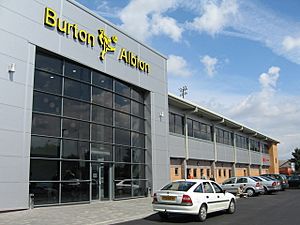
Burton has a rich football history. Since 1888, four different football clubs from Burton have played in the Football League. Today, Burton Albion is the town's main football club. They moved to the Pirelli Stadium in 2005. In 2009, they joined the Football League. The team now plays in League 1, which is the third level of English football.
Burton is also home to the St George's Park National Football Centre, which opened in 2012. This is a training ground for England's national football teams.
The Burton & District Cricket League has many local cricket clubs.
Burton Rugby Football Club, one of the oldest rugby union clubs in the country, started in 1870.
The town also has the Burton Canoe Club and two rowing clubs, Burton Leander Rowing Club (founded in 1847) and Trent Rowing Club (founded in 1863).
Burton Hockey Club was started in 1899. It has many teams for men, ladies, and a youth academy.
The Powerhouse Gym in Burton is home to an International All-Round Weightlifting team. This club trains weightlifters and hosted the 2008 IAWA World Championships.
Town Twinning
Burton upon Trent is twinned with:
- Elkhart, Indiana, United States
- Bielawa, Poland
See also
 In Spanish: Burton upon Trent para niños
In Spanish: Burton upon Trent para niños





